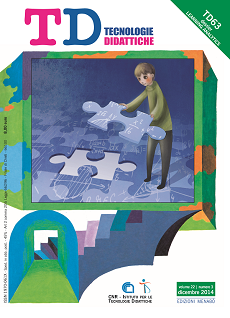The resurgence of community in online learning
Main Article Content
Abstract
Article Details
Section
Authors who publish with this journal agree to the following terms:
- Authors retain copyright and grant the journal right of first publication with the work simultaneously licensed under a Creative Commons CC BY 4.0 Attribution 4.0 International License.
- Authors are able to enter into separate, additional contractual arrangements for the non-exclusive distribution of the journal's published version of the work (e.g., post it to an institutional repository or publish it in a book), with an acknowledgement of its initial publication in this journal.
- Authors are permitted and encouraged to post their work online (e.g., in institutional repositories or on their website) prior to and during the submission process, as it can lead to productive exchanges, as well as earlier and greater citation of published work (See The Effect of Open Access)
References
Boyd, D. (2006). Identity Production in a Networked Culture: Why Youth Heart MySpace. American Association for the Advancement of Science, February 19. St. Louis, MO. Retrieved from http://www.danah.org/papers/AAAS2006.html
Downes, S. (2007, February 3). What Connectivism Is [Web log post]. Retrieved from http://halfanhour.blogspot.ca /2007/02/what-connectivism-is.html
Dubé, L., Bourhis, A. & Jacob, R. (2006). Towards a typology of virtual communities of practice. Interdisciplinary Journal of Information, Knowledge, and Management, 1, 69-93.
Han, S., & Bhattacharya, K. (2001). Constructionism, Learning by Design, and Project Based Learning. In M. Orey. Emerging perspectives on learning, teaching, and technology. Retrieved from: http://epltt.coe.uga.edu/index.php?title= Constructionism%2C_Learning_by_Design%2C_an d_Project_Based_Learning
Kuhn, T. (1962). The Structure of Scientific Revolutions. Chicago, IL: University of Chicago Press.
LeDoux, J. (2003). Synaptic Self: How Our Brains Become Who We Are. Penguin Books. Retrieved from http://www.cns.nyu.edu/home/ledoux/synapticself/
Moore, M. G. (1997). Theory of Transactional Distance. In D. Keegan, Theoretical principles of distance education (pp. 22-38). Routlege Studies in Distance Education.
Polanyi, M. (1966). The Tacit Dimension. New York, NY: Anchor Books.
Siemens, G., & Downes, S. (2008, September 8). Connectivism and Connective Knowledge 2008 (CCK08) [Web newsletter]. Retrieved from http://connect.downes.ca /archive/08/09_08_thedaily.htm
Siemens, G., Downes, S., & Cormier, D. (2011). How This Course Works [Online course post] Retrieved from http://change.mooc.ca/how.htm
Stefanick, L., & LeSage Jr, E. (2005). Limitations to developing virtual communities in the public sector: A local government case study. Canadian Public Administration, 48(2), 231-250. DOI: 10.1111/j.1754-7121.2005.tb02189.x
Wenger, E. (1998). HYPERLINK “http://skat.ihmc.us/rid =1227187866819_1140452997_15052/communities% 20of%20practice_wenger.doc” Communities of practice: Learning as a social system . Systems Thinker, June. Retrieved from http://www.co-i-l.com/coil/knowledge- garden/cop/lss.shtml
Wenger, E. (1999). Communities of Practice: Learning, meaning and identity. Cambridge, UK: Cambridge University Press.
Wenger, E., & Trayner, B.(2004). Communities of practice: a brief introduction. Retrieved from http://wenger-trayner. com/wp-content/uploads/2013/10/06-Brief-introductionto- communities-of-practice.pdf
LETTURE CONSIGLIATE
Bruff, D. O., Fisher, D. H., McEwen, K. E., & Smith, B. E. (2013). Wrapping a MOOC: Student Perceptions of an Experiment in Blended Learning. Journal of Online Learning and Teaching, 9(2). Retrieved from http://jolt.merlot.org/vol9no2/bruff_0613.htm
Day, R., Ker, P., Mackintosh, W., McGreal, R., Stacey, P., & Taylor, J. C. (2011). OERu Open Educational Resource University - Towards a logic model and plan for action. OERu Open Educational Resource University. Retrieved from http://wikieducator.org/images/c/c2/Report_OERU-Finalversion. pdf
Devlin, K. (2012, November 12). MOOC Lessons [Web log post]. Retrieved from http://devlinsangle.blogspot.ca /2012/11/mooc-lessons.html
Hedlund, T., & Rabow, I. (2007). Open Access in the Nordic Countries - a State of the Art Report. The Nordbib programme. Retrieved from http://www.heal-link.gr/SELL/ OA_reports/NordicCountries.pdf
Hill, P., & Feldstein, M. (2013). Everything You Think You Know about MOOCs Could Be Wrong. ELI 2013 Online Spring Focus Session. Retrieved from http://www.educause.edu/eli/ events/eli-online-spring-focus-session/2013/2013/everything- you-think-you-know-about-moocs-could-be-wrong
Hogue, R. J. (2011, May 22). MOOC as Community of Practice [Web log comment]. Retrieved from RJHC: http://rjh. goingeast.ca/2011/05/22/mooc-as-community-of-practice/
Ingeno, L. (2013, May 2). Penn State partners with Coursera, will offer five free, mass online courses. The Daily Collegian [Web log post]. Retrieved from http://www.collegian.psu. edu/archives/article_789fc64b-17b8-5065-97e6- 562e96c1313e.html?mode=jqm
Kolowich, S. (2013, April 8). Coursera Takes a Nuanced View of MOOC Dropout Rates. The Chronicle of Higher Education Wired Campus Blog [Web log post]. Retrieved from http://chronicle.com/blogs/wiredcampus/coursera-takesa- nuanced-view-of-mooc-dropout-rates/43341? cid=wc&utm_source=wc&utm_medium=en
Leal Fonseca, D. E. (2011, March). EduCamp Colombia: Social Networked Learning for Teacher Training. (G. Siemens, & G. Conole (Eds.), The International Review of Research in Open and Distance Learning, 12(3). Retrieved from http://www.irrodl.org/index.php/irrodl/article/view/884/16 77
Reich, J. (2013, May 19). Is a MOOC a Textbook or a Course? Education Week [Web log post]. Retrieved from http: //blogs.edweek.org/edweek/edtechresearcher/2013/05/is _a_mooc_a_textbook_or_a_course.html
Stallman, R. (1996). The Free Software Definition. Free Software Foundation. Retrieved from https://www.gnu.org/philosophy/ free-sw.html
The Daily Create (2013). DS106 [Online course]. Retrieved from http://tdc.ds106.us/

